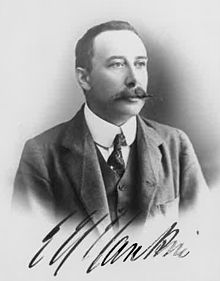Ernest Hanbury Hankin
Ernest Hanbury Hankin , was an English bacteriologist, aeronautical theorist and naturalist. Working mainly in India, he studied malaria, cholera and other diseases. He was among the first to detect bacteriophage activity and suggested that their presence in the waters of the Ganga and Jamuna may have had a role in restricting the outbreaks of cholera. Apart from his professional studies, he took considerable interest in the Islamic geometric patterns in Mughal architecture as well as the soaring flight of birds, culture and its impact on education.
Ernest Hankin was born in Ware, Hertfordshire, his father Rev. D. B. Hankin was later a Vicar of St Judes, Mildmay Grove in North London. He was educated at Merchant Taylors School from 1875 to 1882 and went to study medicine at St Bartholomews Hospital Medical School and matriculated from St Johns College, Cambridge in 1886. He was a Hutchinson Student and Scholar who passed with first class in both parts of the Natural Science Tripos in 1888 and 1889. He took a keen interest in bacteriology and decided against a career in medicine. In 1890 he was elected Hutchinson Student in Pathology and by the end of the year, he was admitted as a Fellow in November. He obtained the degree of MA in 1893 and Sc.D. in 1905 before working under Professor Charles Roy at his Pathological Laboratory in Trinity College London. His early studies in bacteriology included a new staining technique using aniline dyes , some studies on anthrax in collaboration with F.F. Wesbrook, immunity and the role of alexi
Source: Wikipedia

